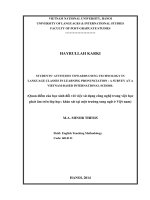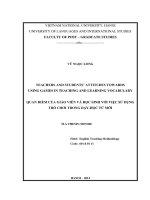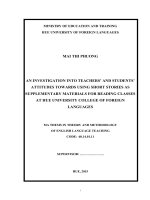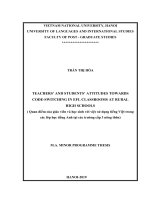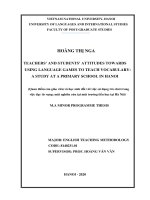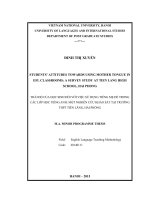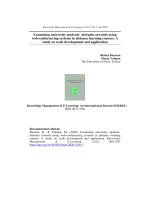students’ attitudes towards using technology in language classes in learning pronunciation a survey at a vietnam-based international school
Bạn đang xem bản rút gọn của tài liệu. Xem và tải ngay bản đầy đủ của tài liệu tại đây (847.29 KB, 45 trang )
VIETNAM NATIONAL UNIVERSITY, HANOI
UNIVERSITY OF LANGUAGES & INTERNATIONAL STUDIES
FACULTY OF POST-GRADUATE STUDIES
********************
HAYRULLAH KARKI
STUDENTS’ ATTITUDES TOWARDS USING TECHNOLOGY IN
LANGUAGE CLASSES IN LEARNING PRONUNCIATION : A SURVEY AT A
VIETNAM-BASED INTERNATIONAL SCHOOL
(Quan điểm của học sinh đối với việc sử dụng công nghệ trong việc học
phát âm trên lớp học: khảo sát tại một trường song ngữ ở Việt nam)
M.A. MINOR THESIS
Field: English Teaching Methodology
Code: 6014111
HANOI, 2014
VIETNAM NATIONAL UNIVERSITY, HANOI
UNIVERSITY OF LANGUAGES & INTERNATIONAL STUDIES
FACULTY OF POST-GRADUATE STUDIES
********************
HAYRULLAH KARKI
STUDENTS’ ATTITUDES TOWARDS USING TECHNOLOGY IN
LANGUAGE CLASSES IN LEARNING PRONUNCIATION : A SURVEY AT A
VIETNAM-BASED INTERNATIONAL SCHOOL
(Quan điểm của học sinh đối với việc sử dụng công nghệ trong việc học
phát âm trên lớp học: khảo sát tại một trường song ngữ ở Việt nam)
M.A. MINOR THESIS
Field: English Teaching Methodology
Code: 6014111
Supervisor: TUAN MINH DO, PhD
HANOI, 2014
i
CERTIFICATE OF ORIGINALITY
I declare that the research paper Students‟ attitudes towards using technology in
Language classes in learning pronunciation: A survey at a Vietnam-based International
school my own work and to the best of my knowledge. It contains no materials previously
published or written by another person. Any contribution made to the research by others,
with whom I have studied at Ha Noi University of Language and International Studies or
elsewhere, is explicitly acknowledged in the thesis.
Hayrullah Karki
Signature: ______________
ii
ACKNOWLEDGMENTS
Many people take a role during this thesis and helped me to accomplish this achievement,
whether directly or indirectly. I am very proud to acknowledge their support.
I dedicate this thesis to my deceased father, who gave me the ambition to reach for the
stars and still be a person among other people.
Special thanks to my family, despite a hundred miles in between give me a warm support.
All of my teachers, from kindergarten to university, have helped guide me to where I am
today in my educational path. And especially my supervisor Mr. Tuan Minh Do for his
inspiring and invaluable guidance, advice, encouragements and everything that I learnt
from him throughout my work.
iii
ABSTRACT
It is an undeniable fact that technology has contributed enormously to the remodeling of
conventional skills of both teaching and learning in Vietnam. English as being an essential
tool in every aspect of our life, is making giant steps not only in Vietnam but also in the
world. Because of above, tremendously important factors, the author delivered a research
named “Students‟ attitudes towards using technology in language classes in learning
pronunciation: A survey at a Vietnam-based international school”. The primary purpose of
this study is to determine to what extent technology contributes in teaching pronunciation
to students, and students‟ attitudes towards technology in a Vietnam-based international
school.
So as to gather information to evaluate the severity of the case on the students‟ perspective,
a questionnaire designed by the author administered to the 21 grade 9 students who are
studying at a Vietnam-based international school named “Horizon International bilingual
school” .The findings gathered from the questionnaire were meticulously scrutinized and
some outcomes were put forward. Considering the substantiality of the these outcomes ,
the author suggested some beneficial advice, and finalized it with the drawbacks and
shortcomings of the thesis.
Findings gathered from the questionnaire revealed that students at HIBS have a great
desire to employ technology to improve pronunciation in order to minimize the factors
inhibiting them from mastering on pronunciation, such as crowded classroom atmosphere,
not having a native or native like teachers, and mother tongue interference.
iv
LIST OF FIGURES AND TABLES
Picture 1: LCD Projector
Picture 2: Audio Laboratory (place A building HIBS)
Chart 1: Question 1
Chart 2: Question 2
Chart 3 : Question 3
Chart 4: Question 4
Chart 5:Question 6
Chart 6 :Question 7
Chart 7: Question 8
Chart 8: Question 10
Chart9: Question 11
Chart 10: Question 12
Chart 11:Question 12.1
Chart 12: Question 5
Diagram 1: Question 9
Picture 3: IPhone
Picture 4: Linguaphone
Picture 5: Talking Dictionary
v
TABLE OF CONTENTS
Page
Certificate of Originality ii
Acknowledgements ii
Abstract…………………………………………………………………… iii
List of figures and tables iv
Table Of Contents v
PART A: INTRODUCTION 1
1. Rationale of the study 1
2. Aims of the study 3
3. Research questions 3
4. Scope of the study 3
5. Methods of the study 4
6. Design of the study 4
PART B: DEVELOPMENT 6
CHAPTER I: LITERATURE REVIEW 6
1.1. Pronunciation and communicative teaching 6
1.2 History and scope of teaching English pronunciation 7
1.3 Approaches to teaching pronunciation 9
1.3.1 Intuitive-imitative Approach 9
1.3.2 Analytic-linguistic Approach 9
1.3.3 Approach of Bottom-up 10
1.3.4 Approach of Top-down 10
1.3.5 Approach of integrating pronunciation 10
1.4 The teacher‟s roles in teaching pronunciation 10
1.4.1 Helping learners hear 11
1.4.2 Helping learners make sounds 11
1.4.3 Providing feedback 11
1.4.4 Pointing out what‟s going on 11
1.4.5 Establishing priorities 11
1.4.6 Devising activities 12
1.4.7 Assessing progress 12
vi
1.5 Pronunciation goal 12
1.6 Computer assisted language learning 12
1.6.1 Structural / Behavioristic CALL 13
1.6.2 Communicative CALL 13
1.6.3 Integrative CALL 13
1.6.4 Studies on Efficacy of CALL 14
CHAPTER II: METHODOLOGY 15
2.1 Introduction 15
2.2 Subject 15
2.3. Instrumentation 15
2.4. Procedures 15
2.4.1.Discussion of the survey questionnaire 16
2.4.2 Presentation of statistical results 16
CHAPTER III: FINDINGS 25
3.1. Findings 25
3.1.1 From Students‟ perspective. 25
3.2 Discussion 26
CHAPTER IV: RECOMMENDATIONS 27
4.1. Suggested equipment/devices for better improving pronunciation 27
4.1.1 Suggestions for students 27
4.1.1.1.Technological devices 27
4.1.1.2.Internet 28
4.1.1.3 Softwares. 29
4.1.1.4 Applications. 30
4.1.2 Suggestions for teachers 30
PART C: CONCLUSION 31
1. Conclusions of the study 31
2. Limitations 31
3. Recommendations for further study 32
REFERENCES 33
APPENDIX 1 I
APPENDIX 2 .III
1
PART A: INTRODUCTION
1. Rationale of the study
Back in 1943, when the first computer was invented, nobody could even imagine that just
in a half of the century this device would be a turning point of history. Since then, they
have increasingly been used in every aspect of human life, starts with education, industry,
science even in marine fish breeding. As a result, information technology became a
substantial cornerstone in every scientific and non-scientific field. Countries across the
world are trying hard to keep pace with latest technological innovations. It is undeniable
that “high-tech” nations are among those countries that have high GDP. In 2006, Vietnam
has made a giant leap by joining to WTO. This made Vietnam be integrated into the world
of information technology in all walks of life, including education.
In fact, IT has contributed enormously to the remodeling of conventional skills of both
teaching and learning in Vietnam. Individuals with a simple click are able to broaden their
horizons by updating the information of their interest through the Internet. In past recent
years, almost all educational institutions pushed the button to launch the campaign of
renovating the methods of teaching and learning. IT, then, has clearly fulfilled its task.
It is obvious that, English is a means of communication in the fields of culture, technology,
science, politics, economy, education and so on English is not only the mother language
of about 375 million of a native speakers around the globe but also the official in many
other countries as well as foreign language in many nations in the world. Following British
colonization from the 16th to 19th centuries, it became the dominant language in the
Australia, New Zealand, United States and Canada. The booming economic and cultural
influence of the United States and its status as a global superpower since World War II
have significantly accelerated the language's spread across the planet. In Vietnam, English
has taken on a historic significance when citizens are carrying out the industrialization and
modernization of “Doi Moi” era in 1986. Since then, the number of individuals who are
learning English is growing rapidly fast. Every single member of Vietnamese society has
been aware of that English is a prime key to be modern, enthusiastic, intellectual. English
has even become a mandatory subject in the syllabus of almost all universities in Vietnam.
HIBS standing for Horizon International Bilingual School is a prestigious school and
training institution with leading quality nationwide in the area of foreign language training
2
at secondary and high school levels; providing customized courses in foreign languages …
Because the school is running a bilingual education , There are two types of Teachers at
HIBS, that‟s Vietnamese teachers and foreigner teachers .Our subject in this thesis is
Vietnamese teachers .Traditionally, English teaching by Vietnamese teachers at HIBS
been dominated by teacher-centered mode. During the lesson, the lecturer who is
considered as the major factor plays on a single-man show, reminding monopoly. He or
she seldom makes any communication with them or asks his/her students any questions.
Teacher tries to seize as many opportunities as possible to impact the students with the
knowledge. The teacher teaches actively while the students listen to him/her passively,
even in some cases can not listen clearly. In return, it brings the individuals poor abilities
and skills of speaking and listening. It is widely known that, speaking skills are the most
influential factors in the process of an integrating to a new society. Good communication
in English depends on proper pronunciation. Diverse dialects can differentiate, but the
crystal clear pronunciation is a paramount factor to make your message be understood.
After completing few English Pronunciation courses for several years, students still remain
at a loss when they have to express themselves in English. Their word power could be
undoubtedly rich of words and structures, but the usage is still insufficient in
communication. So far, the modern world requires that the goal of teaching oral skills, to
be more significant English Pronunciation, needs to enhance students‟ communicative
skills because, only in that way, learners may have expressed themselves and learn how to
follow the social and cultural rules befitting in each communicative competence.
Learning English as a foreign language is quite challenging no matter what learning
materials can be used; however, technology can make learning English Pronunciation
easier and much more exciting. According to Mary Masterson of Georgia State University,
"the text, graphics, video, and audio [of multimedia] encourage immersion in the
language." Indeed, the process of combining two extremely valuable tools in everyday life
such as technology and English Pronunciation learning skills has made an enormous strong
sensation.
As an English teacher working and lecturing at HIBS ,I am well aware of the situation and
It is obvious that students lectured by local teachers have encountered a number of
difficulties in studying of English Pronunciation with a not efficient technological support.
This actually drives me to this research, namely “Students „attitudes towards using
technology in Language classes in learning pronunciation”.
